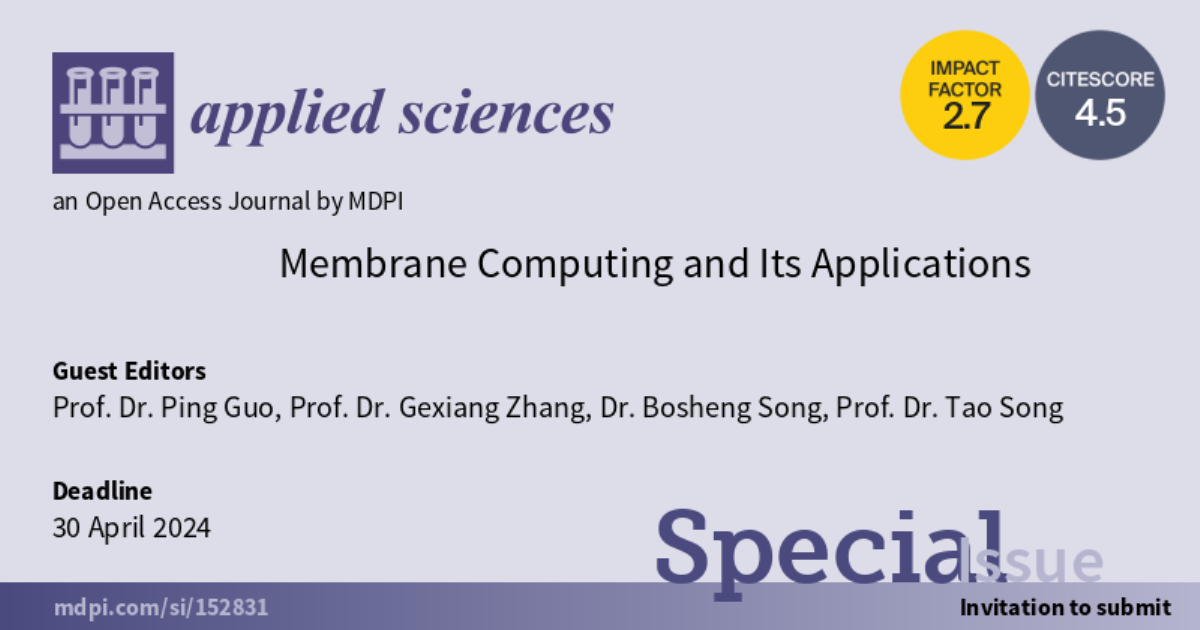Membrane Computing and Its Applications
A special issue of Applied Sciences (ISSN 2076-3417). This special issue belongs to the section "Computing and Artificial Intelligence".
Deadline for manuscript submissions: 30 April 2024 | Viewed by 8156

Special Issue Editors
Interests: biological computing; evolutionary computing; intelligent information systems
Interests: membrane computing; natural computing; artificial intelligence
Special Issues, Collections and Topics in MDPI journals
Interests: membrane computing; bioinformatics
Special Issue Information
Dear Colleagues,
Membrane computing (MC) is a computing paradigm inspired by the structure and functionality of living cells. The theory, method, simulation, and application of membrane computing have developed rapidly since it was proposed by Professor Gheorghe Păun in 1998. The computing system based on membrane computing idea is called the P system, which has been widely combined with computer science, neural computing, natural heuristic optimization, and other disciplines, and has produced a lot of theoretical and application achievements.
This Special Issue aims to publish new ideas and original research results of membrane computing from theory to application, hoping to promote membrane computing to a wider computer science community and promote its wider research and application. Theoretical results, application methods, system design, and simulation implementation are all welcome. The list of topics includes, but is not limited to, the following:
- New architecture and computing model of the P system;
- Computing power of the P system;
- Problem solving method based on the P system;
- Optimization theory and method based on the P system;
- Analysis and design of the P system for NP-hard problems;
- Application of the P system in engineering problems;
- Modeling, verification and simulation tools for membrane systems.
Prof. Dr. Ping Guo
Prof. Dr. Gexiang Zhang
Dr. Bosheng Song
Prof. Dr. Tao Song
Guest Editors
Manuscript Submission Information
Manuscripts should be submitted online at www.mdpi.com by registering and logging in to this website. Once you are registered, click here to go to the submission form. Manuscripts can be submitted until the deadline. All submissions that pass pre-check are peer-reviewed. Accepted papers will be published continuously in the journal (as soon as accepted) and will be listed together on the special issue website. Research articles, review articles as well as short communications are invited. For planned papers, a title and short abstract (about 100 words) can be sent to the Editorial Office for announcement on this website.
Submitted manuscripts should not have been published previously, nor be under consideration for publication elsewhere (except conference proceedings papers). All manuscripts are thoroughly refereed through a single-blind peer-review process. A guide for authors and other relevant information for submission of manuscripts is available on the Instructions for Authors page. Applied Sciences is an international peer-reviewed open access semimonthly journal published by MDPI.
Please visit the Instructions for Authors page before submitting a manuscript. The Article Processing Charge (APC) for publication in this open access journal is 2400 CHF (Swiss Francs). Submitted papers should be well formatted and use good English. Authors may use MDPI's English editing service prior to publication or during author revisions.
Keywords
- membrane computing
- P system
- membrane computing model
- cell-like P system
- tissue-like P system
- spiking neural P systems
- P system application
- P system simulation
- optimization algorithm
- NP hard problem





